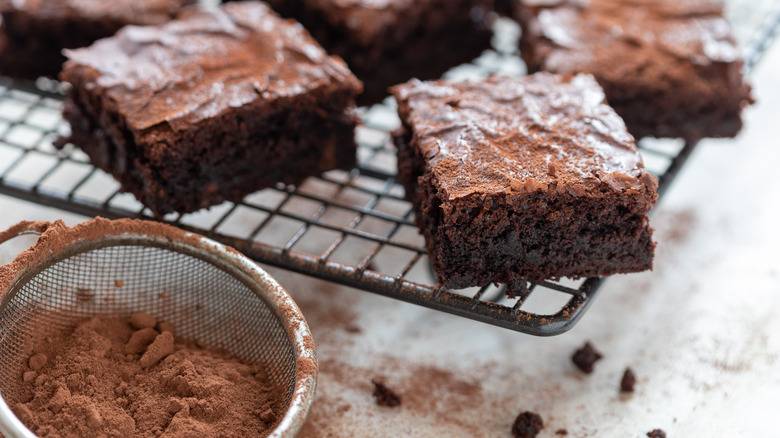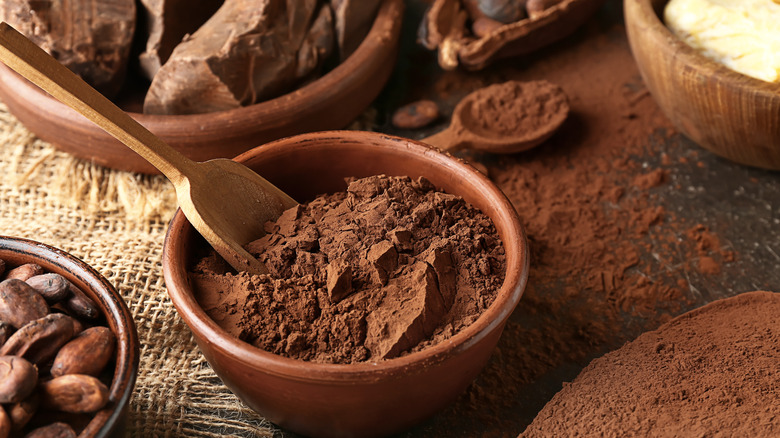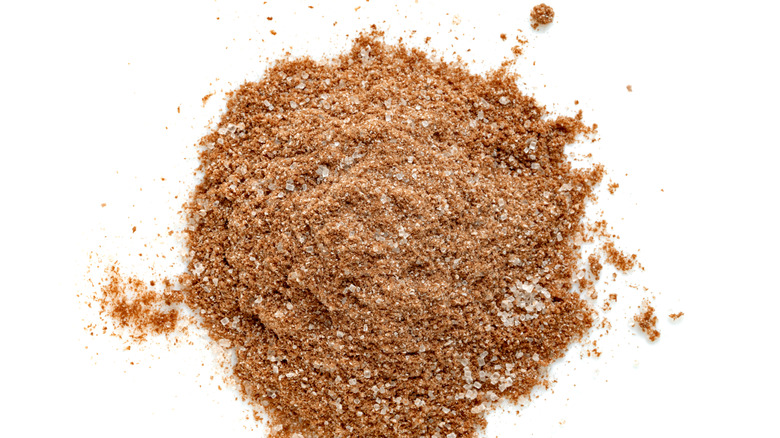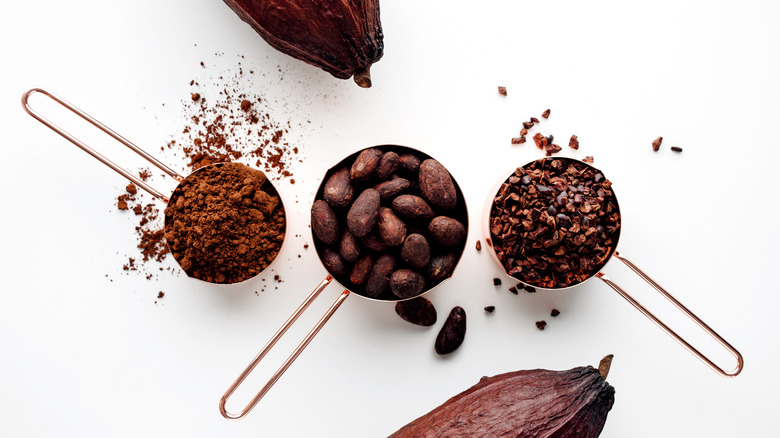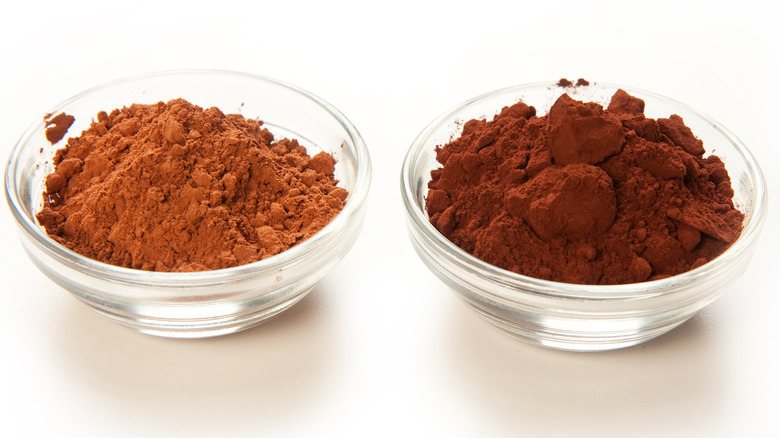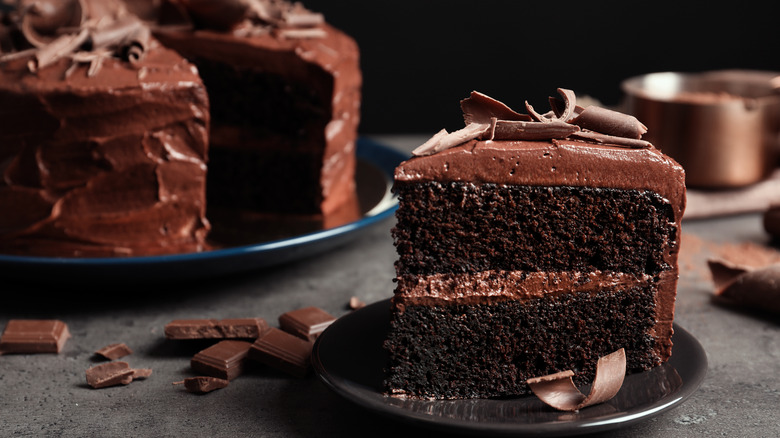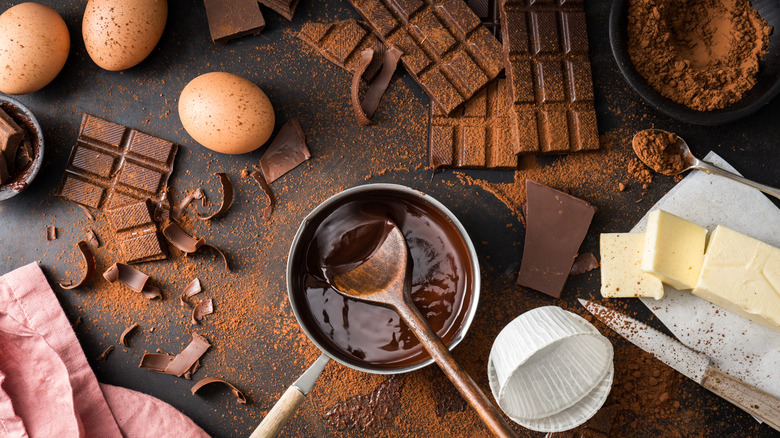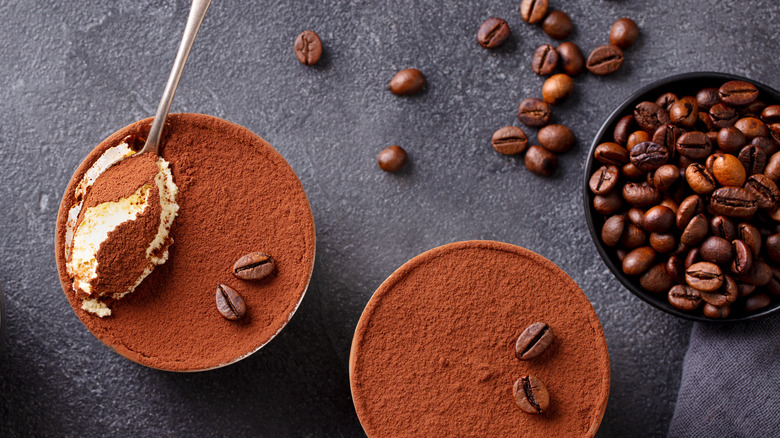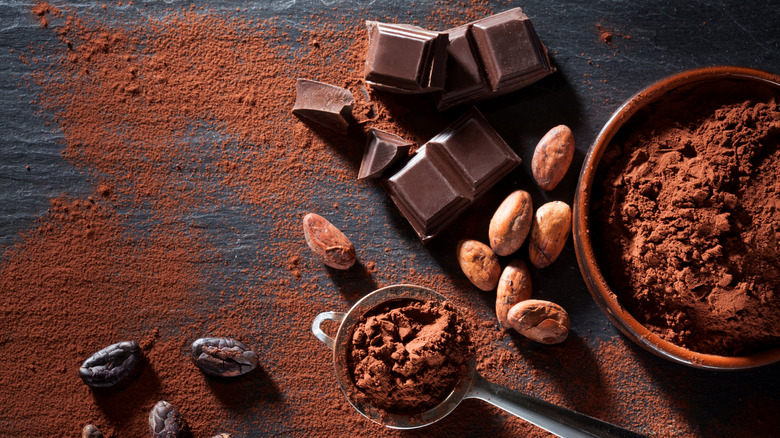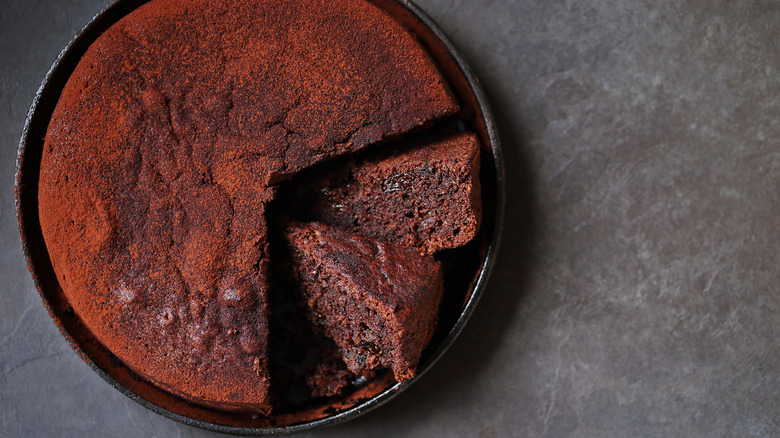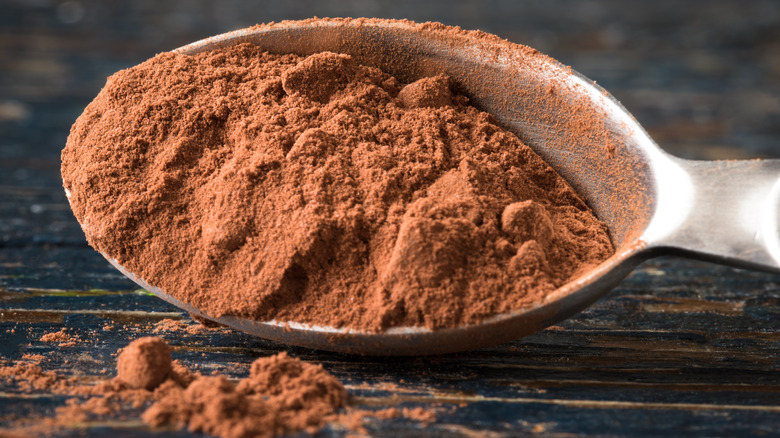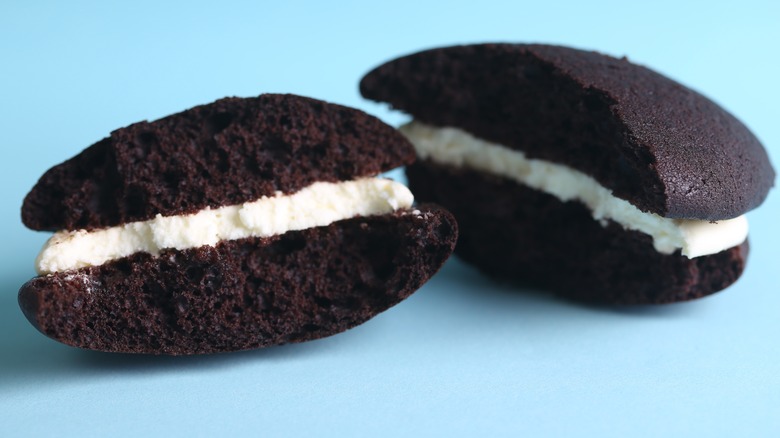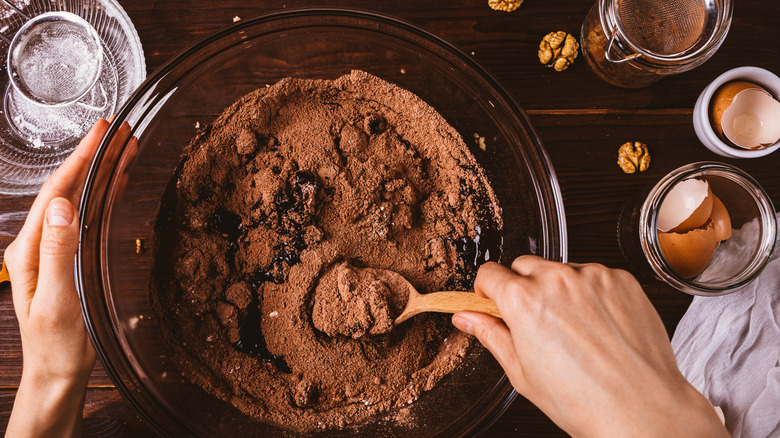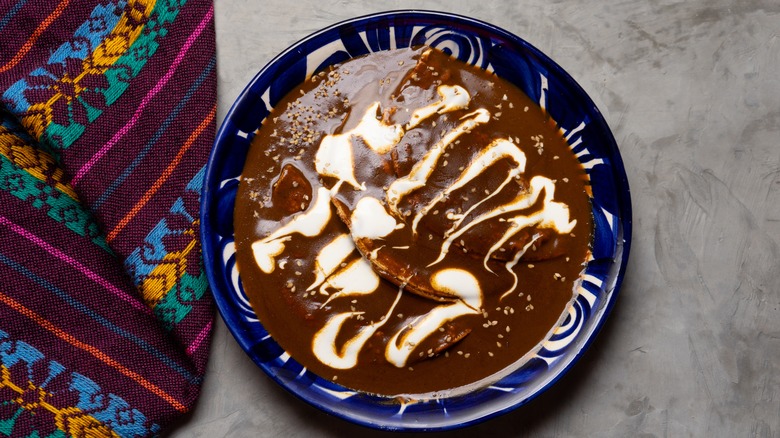What You Need To Know Before Baking With Cocoa Powder
Cocoa powder should be a staple in almost every pantry, even if you're only a casual baker. It's a far more versatile ingredient than you may think, there for you whenever you're craving a batch of brownies, sure, but also when you need a cup of homemade hot chocolate, or even a new way to spice up a savory dish.
While cocoa powder may seem basic (not that there's anything wrong with that), it is in fact a bit more complicated than you may realize. There are some key things to know about how cocoa powder is made and how it should be used to ensure you're getting the most out of this common baking ingredient. For instance, it provides a lot more than just deep chocolate flavor in your baked goods, affecting the texture of cakes and cookies as well as the taste — and different types of cocoa powder, from Dutch-process to black cocoa, have their own idiosyncratic quirks. Different brands also vary widely in color, flavor, and fat content, so they can produce wildly different results.
No matter what kind you buy, how you store your cocoa powder matters, as does how you measure it. And there are some nifty tricks you can try with cocoa powder to elevate your baking to a whole other level, whether you're sticking with the familiar Hershey's or splurging on a beloved pro baker brand like Valrhona. So here's everything you need to know before baking with cocoa powder again.
The fat content of cocoa powder is key
Cocoa powder is made from fermented, roasted cocoa beans that are pressed in order to extract their cocoa butter, which is used for making chocolate bars, chips, and candy, as well as in other products, including cosmetics. The dry solids that are left behind after the cocoa butter is expelled are finely ground and packaged as cocoa powder, baking cocoa, or unsweetened cocoa (we'll get into Dutch-processed cocoa powder in just a bit).
While the process of making cocoa powder naturally strips out most of the fat, some is left behind. However, the specific percentage varies widely from brand to brand, from a mere 10% to 26% (per Handle the Heat). The lower the percentage of fat in cocoa powder, the less luscious anything you make with it will be. Higher-fat cocoa powder also has a more powerful chocolate flavor. That said, most products don't advertise their higher fat content, so how do you tell how much is in your cocoa powder? Check the nutrition label and choose a cocoa powder with at least 1 gram of fat per serving. A lower-fat cocoa powder like Hershey's will have about 0.5 grams of fat per serving.
In a post for Food52, chocolate baking extraordinaire Alice Medrich echoes this advice and points out that since most recipes call for such a small amount of cocoa powder overall, there's no reason to fear a higher fat percentage. Besides, you're baking; a little indulgence is the whole point.
No, cocoa isn't cocoa powder
This may seem obvious to some, but it must be said: The very similarly named cocoa powder and hot cocoa are not one in the same. Pure cocoa powder contains only cocoa (and sometimes alkali). Hot cocoa mix, on the other hand, combines cocoa with sugar, and usually also contains other ingredients. These may include milk solids, coconut oil, corn syrup, salt, and a bevy of additives and preservatives.
Clearly, you can't typically just use Swiss Miss in place of plain cocoa powder in a pinch, but that doesn't mean you can't also bake with hot cocoa or instant cocoa mix. Your best bet is to find a recipe that is written specifically to use cocoa mix, like the hot cocoa brownies from Cookie Dough and Oven Mitt or the hot chocolate cookies developed by Love from the Oven.
If you try to substitute hot cocoa mix for cocoa powder in another recipe, you'll probably throw off both the flavor and the texture of your finished dish. However, if the total amount is negligible — say, a few tablespoons versus a whole cup — it's worth a shot. Just know the taste will be less deeply chocolatey and rich, and the overall sweetness will be greater, unless you decrease the sugar called for in the recipe. Conversely, you also can't make a cup of hot chocolate from cocoa powder alone; you'll need to add sugar, plus any extras you like, from vanilla to a sprinkle of cinnamon.
Cacao powder isn't cocoa powder either
As close as the spelling may be, they are two distinct substances — although cocoa powder and cacao powder are far more similar than cocoa powder and hot cocoa mix. The word cacao simply means chocolate, and cacao comes from the same place as cocoa: the Theobroma cacao tree (per Chowhound). Cacao powder is made in the same manner as cocoa powder, except the fermented beans are not roasted before being pressed, dried, and ground (per The Spruce Eats). Therefore, cacao powder is considered a raw product and contains more nutrients, minerals, and antioxidants than more heavily processed cocoa.
If you substitute cacao powder for cocoa powder in baking, the high heat over prolonged cooking times will destroy some of its nutrients (per All Recipes) — so if you're choosing it specifically for the health benefits, it's best to use it in raw applications or less intensely heated things like hot chocolate.
Since cacao powder is also more intense and bitter, the flavor of the finished dish will be less sweet than if you use cocoa — unless, of course, you compensate with a bit more sugar than the recipe calls for. There's just one more thing to be aware of: Cacao powder is more absorbent than cocoa powder, meaning it will suck up more of the liquid ingredients in a recipe and may negatively affect the texture of the finished dish (per Jessica Gavin).
What's Dutch-process cocoa?
When we're talking about cocoa powder without any qualifiers, we're talking about natural cocoa powder — but Dutch-processed cocoa powder, also known as Dutched cocoa, is another common variety that's not always interchangeable. The cocoa beans for Dutch-process cocoa powder are "washed in alkaline solution of potassium carbonate" which effectively wipes out the acidity (per Sally's Baking Addiction). The less acidic cocoa powder is darker, more easily dissolved, less bitter, and also a bit less chocolatey in flavor.
Unlike cocoa powder, Dutch cocoa is not acidic, which means it will not react properly with alkaline baking soda to make baked goods rise — though if other acids like buttermilk or molasses are present in the recipe, it might work out okay (per Baker Bettie). And if a recipe calls for baking powder, either regular or Dutch powder works, but it's always a safe bet to stick with what the recipe asks for. (When in doubt, just go with the default natural cocoa powder.) In recipes without any leavening, like frosting, you can use whichever cocoa powder you prefer.
Further complicating things, not all Dutched cocoa powder is labeled as such, but if it says "alkali" or "Dutch" anywhere in the ingredients list, then that's what you have. If it only lists cocoa, it's probably the natural, untreated kind, which can be used with any leavening agent without deflating your hopes and dreams.
How cocoa powder impacts texture
Ever wondered why some recipes for the same things — brownies, for instance — call for melted chocolate and others call for cocoa powder? They each add slightly different dimensions of chocolate flavor to baked goods, but they also affect the texture in different ways. Using melted chocolate in the batter for brownies may seem like the more luxurious route to moist and fudgy goodness, but if you leave the dessert out at room temperature, the consistency can take a hit (per The Kitchn). Making brownies with dry, lower-fat cocoa powder, by contrast, adds concentrated chocolate flavor and results in a rich, fudgy texture — as long as the recipe has the appropriate amounts of sugar and fat (per Epicurious).
When it comes to things like mousse and pudding, melted chocolate is generally preferable, since its firmed-up fat will contribute to a plush texture, and there are generally no dry ingredients to steal any of that moisture. If you're all out of chocolate, though, you can make ganache with cocoa powder, but it will be thinner (per Cook'n). Similarly, cocoa powder mousse will be less fluffy and luscious. Plenty of recipes call for both chocolate and cocoa powder so you can get the best of both worlds. And if you have a chocolate cake that includes cocoa powder, be wary of cake flour because, as Sally's Baking Addiction noted, that pairing often results in a dry, crumbly cake.
You should measure and sift cocoa powder properly
Baking, as you've probably heard, is a science, and even slight variations in ingredient amounts can potentially have big impacts. Since cocoa powder affects baked goods' texture as well as flavor, it's especially important to use the right amount, particularly when you're dealing with more than a few tablespoons.
You should measure cocoa powder like you should measure flour: by scooping it into a cup with a spoon and leveling off the top, or by weighing it on a kitchen scale. In addition, you should be sifting cocoa powder, which is notoriously clumpy. Wondering if you should sift before or after you measure? Some recipes kindly specify. A hot fudge sauce from New York Times Cooking calls for "1 ¼ cups sifted high-fat Dutch-process cocoa like Valrhona, Pernigotti or Droste (sift, then measure)," leaving no one guessing. Other recipes will simply say, "cocoa powder, sifted" (indicating that you measure before sifting) or "sifted cocoa powder" (indicating that you sift before measuring).
If yours doesn't spell it all out, though, you should sift first and then measure (per The Kitchn). That way, you get all those tiny lumps out and aerate the cocoa powder so you end up with the correct amount by volume. Don't have an old-fashioned flour sifter? Use a whisk to break up the cocoa powder clumps, or shake it through a fine mesh sieve — in fact, that often works better for cocoa powder's teeny tiny clumps. You can even use a tea strainer.
You can bloom cocoa powder for more intensity
Blooming isn't just for flowers. Maybe you've heard of blooming spices, or briefly cooking them in hot oil or other fat to coax out all the nuances of their flavor. You can bloom cocoa powder too. This is typically done by adding hot water to cocoa powder before combining it with other ingredients, but you could potentially use any hot liquid (per Sweet Cookie Crumbs) — just let the mixture cool to room temperature before adding it to anything with eggs, lest they scramble.
Blooming cocoa powder brings out its full complexity of flavor and deepens its chocolatey essence, and has the added benefit of busting up all those aforementioned lumps, so if you don't plan on sifting, this can be a handy trick (per The Kitchn). Just be sure to stir the cocoa powder into the hot liquid to completely dissolve it and encourage the smoothest texture. If your recipe doesn't call for blooming cocoa powder, you can still try it anyway — even if there's no liquid like milk or water in the ingredients list. If there is melted butter or oil, you can bloom the cocoa powder in either of those.
The Spruce Eats cautions that blooming cocoa powder for too long or at too high a temperature can up the bitter flavor ante. Speaking of heat, the site advises against melting cold butter while blooming because it can totally create an unwanted texture.
Coffee can amp up cocoa powder too
Using strongly brewed coffee or espresso powder to intensify the chocolate flavor of myriad desserts is an old trick, and a good one. You only need a small amount of coffee or espresso to make your chocolate treat taste even more like chocolate — without turning it into a mocha flavored dessert. If your recipe calls for any liquid like water or milk, you can replace a small amount of it with strongly brewed coffee or espresso instead; just let it cool before mixing it with ingredients that might curdle or melt.
For recipes that don't contain any such liquid component, you're better off adding a pinch of espresso powder, which, as King Arthur Baking notes, "is not the same as instant coffee." You can tear open a Starbucks Via sleeve and dump it into your dry ingredients if it's all you've got, but espresso powder is far more concentrated. A teaspoon is all you need. If you're using instant coffee, add two teaspoons, but beware that you may be edging into bitter flavor country if you do.
A chocolate cake recipe from My Baking Addiction demonstrates several tricks: using coffee to amp up the cocoa, adding both oil and buttermilk to compensate for cocoa powder's drying effects, and combining both natural cocoa powder and Dutch-process cocoa for a richer, more complex chocolate flavor. For extra brownie points, try blooming the cocoa in the hot coffee before cooling it and adding to the wet ingredients.
There are some good substitutes for cocoa powder
If you're out of cocoa powder, what can you use instead? Natural cocoa powder works in place of Dutch-process cocoa without making any other adjustments to the recipe. If you use Dutch-process cocoa powder in place of regular cocoa powder, be sure to look at the recipe's leavening. If the recipe calls for baking powder, you don't need to add anything when swapping in Dutched cocoa. If you're working with baking soda, you're going to need some acidity, and Baker Bettie suggests you throw in "a pinch of cream of tartar or 1/8 tsp of lemon juice or vinegar for every 3 TBSP of cocoa powder."
Cacao powder can be used instead of either type of cocoa powder, but Jessica Gavin recommends using less than the recipe calls for, otherwise your baked goods will be a bit less sweet. Carob powder, which comes from a totally different plant and packs more sweetness than cocoa powder, can be used too, though you may wish to slightly decrease the amount of sugar (per The Spruce Eats).
Unsweetened chocolate, or baking chocolate, is another good substitute for cocoa powder, but you'll have to account for its additional fat. Use 1 ounce of unsweetened chocolate for every 3 tablespoons of cocoa powder called for, and decrease the total amount of butter, oil, or other fat by 1 tablespoon (per The Spruce Eats).
You can use cocoa powder to flour baking pans
Many recipes for cakes, bar cookies, and brownies call for lining the pan with parchment, or for buttering and flouring it. This is primarily to make sure the baked goods in question don't stick to the pan, but buttering and flouring can also add a delicate crust (per Food52), and help the batter rise without slumping down again when the dessert cools.
If you're a fan of the butter and flour method, you should know that cocoa powder can be used instead of flour. This is a particularly neat trick for chocolate cakes, as the cocoa powder will give them a darker, richer color and enhance the flavor (per Los Angeles Times). Try it for chocolate Bundt cakes too, in which case, use melted butter and a pastry brush to coat every little intricate detail of the pan before sprinkling in the cocoa. It's also a good move for ramekins when making molten chocolate lava cakes (per Reddit).
In any case, you only need about a tablespoon of sifted cocoa powder. First, coat your pan with a thin, even film of butter or shortening, then sprinkle in the cocoa powder (over the sink to minimize mess). Rotate and tilt the pan while tapping the sides to help distribute the cocoa evenly, then turn the pan upside down and tap out the excess cocoa powder. Caution: Do not try this with cocoa mix, as the added sugar will likely burn.
Cocoa powder can go bad
The rules around expiration dates and sell-by dates are complicated, to say the least, but you've probably never really worried about your cocoa powder going bad. As it turns out, it totally can. Over time, cocoa powder will lose its intensity, but as long as it smells and looks okay, you can continue to use it until your package is empty. In fact, cocoa powder should last up to "two to three years past the printed expiration date," according to Can It Go Bad.
Been even longer since you cleaned out your cupboards? Cooks Illustrated experimented with a box of cocoa powder that'd been "expired" for six years and plenty of testers couldn't taste much of a difference. While it's not a common occurrence, it is possible for cocoa powder to spoil and even grow mold.
You should store cocoa powder in a cool, dark, dry place like a pantry or cupboard. Never put cocoa powder in the refrigerator or freezer. While it may seem like that would help prolong its lifespan, the higher moisture content in the atmosphere can actually encourage the growth of bacteria. Conversely, storing cocoa powder in a place that gets too warm can cause the residual fat content to turn rancid, which won't taste very good. In any case, be sure your cocoa powder is in a tightly sealed container to prevent humidity from wreaking havoc with the contents. Also, always use clean spoons when measuring cocoa powder to avoid introducing bacteria into the container.
Black cocoa powder is another type to look for
Natural and Dutch-process cocoa powder are by far the most common types on supermarket shelves and will serve you well in all your baking endeavors, but black cocoa is another one worth seeking out. A key ingredient in Oreos (per The Kitchn), black cocoa is made by the same process as Dutched cocoa, but treated even more intensely with the alkaline solution so its acid is thoroughly neutralized. Therefore, the same rule about paying attention to a recipe's leavening agent applies when using black cocoa.
Black cocoa powder will make your baked goods extremely dark in color — perfect when you want a black velvet crumb — and deeply chocolatey, but if you use it alone, you'll also end up with a drier cake or cookie that tends to crumble. This is because black cocoa powder contains even less fat than usual. It's best to use it in conjunction with another type of cocoa powder.
You can buy ready-made blends from several brands, including King Arthur Baking, which offers Double-Dutch Cocoa Blend (black cocoa and regular Dutch-process cocoa powder), and Triple Cocoa Blend (which combines regular Dutch-process, black cocoa, and natural cocoa). They also provide a great breakdown of how these different options affect the flavor and texture of chocolate cakes and brownies. If you're using a blended cocoa that contains natural, non-Dutched cocoa powder, you should be able to use it in any recipe, regardless of the leavening agent.
What's the best brand of cocoa powder?
What's the best brand of cocoa powder to buy? It truly depends on your personal preferences and how you plan to use your cocoa. In testing various brands and types of cocoa powder, Cook's Illustrated found that Dutch-process cocoa tended to produce the best results, both in flavor and texture, but the fat content of the cocoa powder was also important.
They picked Droste cocoa as their favorite — funnily enough, it's one of those brands that doesn't say "Dutch" on the front of the package and also, on some boxes, doesn't even say "Dutch" or "alkali" in the ingredients list. It is, however, Dutched cocoa. Guittard Dutch-process cocoa powder was in second place. While they weren't nearly as impressed with Hershey's Cocoa, it was their testers' favorite natural cocoa powder. Perhaps because this is such a common cocoa brand — maybe even what your childhood brownies were baked with — it's generally liked by most testers, including Taste of Home. It also has the benefit of being usable in any recipe, no need to worry about leavening agents.
If you want to explore all the nuances of chocolate flavor, though, you'll likely want to stock a fancier brand for certain bakes. Stella Parks reviewed several high-quality brands of Dutch cocoa powder for Serious Eats, noting how each one influenced the flavor and texture of a batch of brownies. Tessa Arias of Handle the Heat broke down her favorite brands as well, including Bensdorp and Penzeys.
You can use cocoa powder for more than baking
Even if you hardly ever bake, cocoa powder is worth keeping around. You already know it'll last a long time, but you can also use it in far more than cakes, cookies, brownies, and frosting. Try adding cocoa powder to a savory dry rub, like this one from All Recipes. The cocoa adds a layer of complex flavor that works with all sorts of things, from chicken and beef to pork ribs and even tofu.
You can also use cocoa powder in a quick mole, the complex Mexican sauce that often contains chocolate. Traditional mole recipes take a long time to simmer and call for a lot of ingredients — and are absolutely worth it, but if you want those same basic flavors in way less time, Gimme Some Oven's 20-minute mole makes good use of unsweetened cocoa powder. Try adding a pinch to your next batch of chili too.
You also never need to buy hot cocoa mix again (unless you really love those dehydrated marshmallow bits). You can make homemade hot chocolate that tastes way better than the packaged stuff with unsweetened cocoa powder and sugar. Mix them together with a little liquid to smooth out all the lumps and dissolve both dry ingredients, then pour in your hot water, milk, or cream. You can also experiment with add-ins like vanilla, cinnamon, cardamom, or other spices — although if you skip the extras, you'll get a better sense of your cocoa powder's specific flavor.
